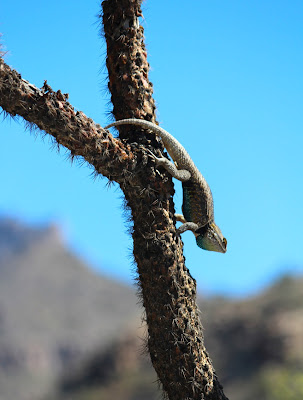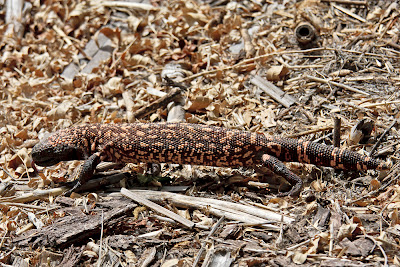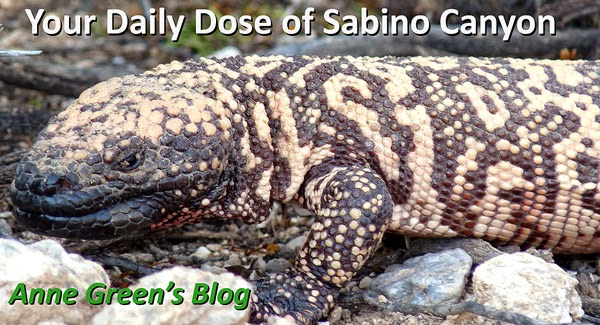 |
| Photo by Ned Harris 4/25/2012 |
Monday, April 30, 2012
Twin Seed
Sunday, April 29, 2012
Roadrunner chicks
 |
| Photo by Ned Harris 4/25/2012 |
Saturday, April 28, 2012
Asparagus Stalk
 |
| Photo by Angie Perryman 4/24/12 |
Friday, April 27, 2012
In the Phlox Family
 |
| Photo by Kenne Turner 4/20/2012 |
Thursday, April 26, 2012
Rattle, rattle
 |
| Photo by Marty Horowitz 4/21/2012 |
Wednesday, April 25, 2012
Buds
 |
| Photo by Marty Horowitz 4/21/2012 |
If you said: Goodding Willow for the cottony 'snow' from yesterday's post, you sneeze!
Tuesday, April 24, 2012
Looks like snow!
Monday, April 23, 2012
Deer in the willows
 |
| 4/18/2012 |
 |
| 4/18/2012 |
Photos and Text from Mark Hengesbaugh:
Sabino’s native white-tailed deer don’t eat the invasive Arundo donax (Giant Reed), but now that we’ve cleared out the Arundo thicket at the dam they can get to the tasty Goodding willows.
Sunday, April 22, 2012
Packrat and Prickly Pear
 |
| Photo by Walt Thomas |
Saturday, April 21, 2012
Friday, April 20, 2012
Staghorn blossom
 |
| Photo by Marty Horowitz 4/17/2012 |
If you are interested in looking up what scientific names mean, try the Botanary (botanical dictionary). Type the name in the search box in the upper right.
And if you are interested in the mathematics of plant growth, Smith College has great resources.
Thursday, April 19, 2012
Spiny workout
 |
| Photos by Marty Horowitz 4/17/2012 |
 |
Wednesday, April 18, 2012
Nice looking monster!
 |
| Photo by Bob Wenrick 4/10/12 |
Tuesday, April 17, 2012
Hummingbird Banding
Monday, April 16, 2012
The biggest bee you'll ever see
 |
| Photo by Ned Harris 4/4/2012 |
Sunday, April 15, 2012
The Two Tigers
 |
| Photo by Bob Wenrick 4/11/2012 |
Tiger Whiptails are usually found in the lower canyon. If you see a whiptail in the area around the visitor center, you can be reasonably certain it's a Tiger.
Saturday, April 14, 2012
Red-spotted Toad
 |
| Photo by Fred Fisher 3/28/2012 |
Friday, April 13, 2012
A new snake
 |
| Photo by Mark Hengesbaugh |
Thursday, April 12, 2012
G is for Greater Earless
 |
| Photo by Ned Harris, 3/28/2012 |
I recommend this site: Reptiles and Amphibians of Arizona, for those interested in more info about these amazing animals.
Wednesday, April 11, 2012
It's a halo!
 |
| Photo by Peggy Wenrick 4/10/2012 |
On the plant walk yesterday, we saw (among many other things) this ring around the sun. One was spotted in Sydney Australia last month. According to this weather service site, a complete ring is called a halo; if there are only two spots on either side, it's a sun dog:
In ages past, the huge rings or haloes around the sun or the moon were thought to portend everything from storms to great personal disasters. We now know that they are the optical result of the refraction of light from the sun or moon by ice crystals in the very high cloud (25,000 feet or higher) called cirrus or cirrostratus. On occasion, only two bright spots on either side of the sun can be seen. These are known as sun dogs and are caused when the ice crystals occur in a certain uniform arrangement.
Tuesday, April 10, 2012
Pipevine and those who eat it
 |
| Photo by Ned Harris, 4/2/2012; Hand by Fred Heath |
 |
| Photo by Bob Wenrick 4/4/2012 |
Monday, April 9, 2012
Butterflies!!
 |
| All Photos by Bob Wenrick 4/4/2012 |
Marine Blue on a Cryptantha species.
Spring Azure on Fairy Duster (Calliandra eriophylla).
 |
| Just hangin' around.. |
Sunday, April 8, 2012
Bell's Vireo making nest
 |
| Photo by Bob Wenrick 4/4/2012 |
 |
| Photo by Bob Wenrick 4/4/2012 |
 |
| Photo by Ned Harris 4/4/2012 |
Saturday, April 7, 2012
Friday, April 6, 2012
Coming soon...butterflies
 |
| Photo by Ned Harris 3/28/2012 |
Thursday, April 5, 2012
Hedgehog in Bloom
 |
| Photo by Ned Harris, 4/4/2012 |
Wednesday, April 4, 2012
Three Borages
| Photo by Matt Ball 3/22/2012 |
From left to right: Wild Heliotrope Phacelia distans (purple); Cryptantha, likely Cryptantha barbigera (white); and Fiddleneck Amsinckia menziesii var. intermedia (yellow-orange). These are all in the Borage Family (Boraginaceae), are spring (Feb-Apr) bloomers, and have flowers on curved stalks.
Tuesday, April 3, 2012
Fruiting Hop Bush
| Photo by Matt Ball 3/22/2012 |
Monday, April 2, 2012
Sunday, April 1, 2012
Baby Hummers
 |
| Photo by Matt Ball 3/31/2012 |
If you are interested in seeing hummingbirds up close and personal, the next banding in Sabino Canyon is Saturday 4/7. We start at sunrise (c. 6am this weekend) and continue 5 hours. Come early for the best viewing opportunity. Hummingbirds have to eat immediately after 'waking' and they know where the feeders are!
Subscribe to:
Posts (Atom)







